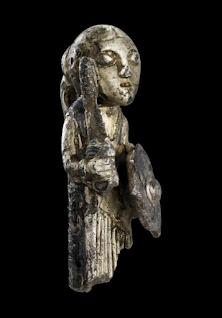 |
| Winonisis by Christopher T. |
I realized too that it was the first day of the festival of Isis and Osiris, the Ancient Egyptian myth that was spun into the Mary and Jesus resurrection story in the bible. I'd connected my mother to the myth, but not, heretofore, Winona.
My mother's name was Inez, which we pronounced "I-nis" (a little like "I-sis"). When I was very young, I thought her name was "Icing," which is what I called the satin border sewn onto my baby blanket. I used to like to fall asleep fingering that soft, comforting strip of satin. I remember feeling the coolness of it the night I had a 104 degree temperature with the measles, and Mom stayed up all night rubbing me down with isopropyl alcohol while I hallucinated.
I have the great good fortune of knowing Ryder's parents as colleagues and mentors. In 1982, Michael Horowitz and Cynthia Palmer published the book Shaman Woman, Mainline Lady (aka Sisters of the Extreme), which first opened my eyes to the connection between cannabis and the female. It is on their giant shoulders that I stand, and they couldn't be more gracious, helpful or inspiring to me in my quest to uncover even more Shaman Women. Horowitz was also Timothy Leary's archivist, which is how Leary famously became Ryder's godfather.
Because we are in touch, they recommended I watch "Stranger Things" on Netflix, which in case you're aren't aware, is quite the phenomenon. In the last two nights' time I've managed to bingewatch all gripping episodes as a nod to Halloween/Samhain.
In it, Ryder's character's son is taken to the underworld and she must rescue him. That's so Isis.
I love that the show touches on MK-ULTRA, the CIA program that dosed unprepared participants with LSD to develop the sacrament as a weapon. The program, which was exposed in the Church Committee hearings, did much to unravel the peace movement of the 60s as well as, I discovered yesterday at the Oakland Museum, the Black Panthers.
Today, as a friend points out, it is very troubling that "ISIS" has become the known name of a terrorist group. Perhaps that is why President Obama more properly calls them ISIL.
More on Winona in How to Make an American Pot Party.









